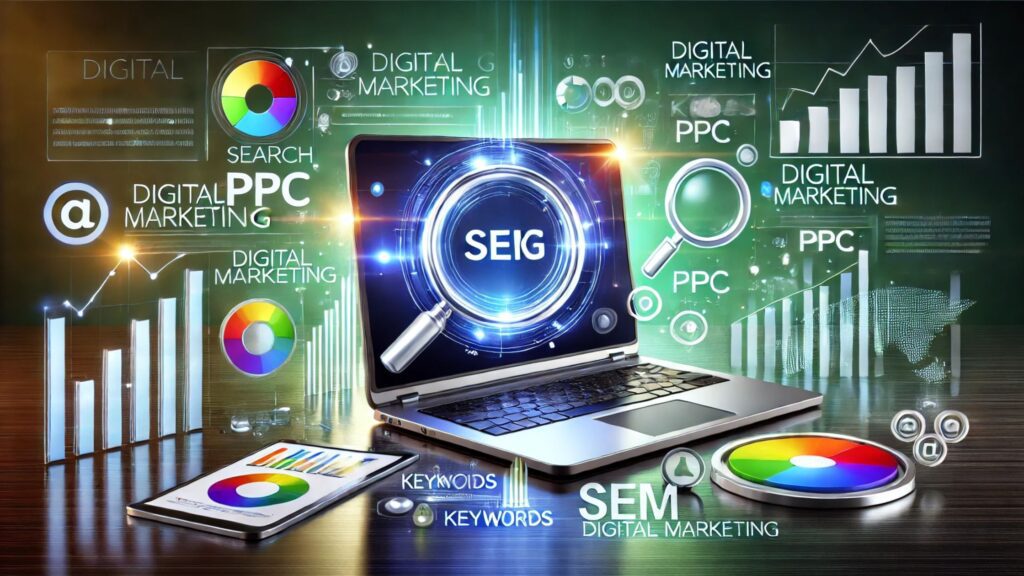
In today’s digital-first world, businesses are increasingly leveraging Search Engine Marketing (SEM) as a critical component of their digital marketing strategy. SEM digital marketing is a powerful way to drive traffic, generate leads, and boost conversions by making your brand more visible on search engine results pages (SERPs). Let’s dive into the essentials of SEM digital marketing and explore how it can benefit your business.
What is SEM Digital Marketing?
SEM, or Search Engine Marketing, refers to the use of paid advertising on search engines like Google, Bing, and Yahoo to promote your website. Unlike SEO, which focuses on organic traffic, SEM involves paid strategies such as Pay-Per-Click (PPC) ads and display ads to achieve immediate visibility and results.
Key Components of SEM Digital Marketing
- Keyword Research: Effective SEM campaigns start with thorough keyword research. Tools like Google Keyword Planner or SEMrush help identify the most relevant and high-performing keywords for your target audience.
- PPC Advertising: Pay-Per-Click ads are the backbone of SEM. These ads appear at the top of SERPs, and you pay only when a user clicks on your ad. PPC platforms like Google Ads allow businesses to bid on keywords relevant to their industry.
- Ad Copy Creation: Crafting compelling ad copy is vital for SEM success. Your ad should include relevant keywords, a clear call-to-action (CTA), and value propositions that resonate with your audience.
- Landing Page Optimization: A high-quality landing page improves user experience and increases conversion rates. Ensure your landing pages are optimized for speed, relevance, and mobile responsiveness.
- A/B Testing: Experiment with different ad formats, headlines, and CTAs to determine what resonates best with your audience. A/B testing helps refine your campaigns for maximum efficiency.
- Analytics and Reporting: Use analytics tools to track the performance of your SEM campaigns. Metrics such as Click-Through Rate (CTR), Cost-Per-Click (CPC), and Return on Ad Spend (ROAS) provide insights into your campaign’s success.
Benefits of SEM Digital Marketing
- Immediate Visibility: Unlike SEO, which can take months to show results, SEM provides instant visibility on SERPs.
- Highly Targeted Advertising: SEM allows businesses to target specific demographics, locations, and user behaviors, ensuring your ads reach the right audience.
- Cost-Effective: With PPC, you pay only when someone clicks on your ad, ensuring you get value for your investment.
- Measurable Results: The performance of SEM campaigns is easily measurable, allowing you to adjust strategies in real-time.
- Increased Brand Awareness: Even if users don’t click on your ad, appearing at the top of search results increases your brand’s visibility.
How to Get Started with SEM Digital Marketing
- Set Clear Goals: Define what you want to achieve—whether it’s increasing website traffic, generating leads, or boosting sales.
- Choose the Right Platform: Decide whether Google Ads, Bing Ads, or other platforms are most suitable for your target audience.
- Budget Allocation: Start with a manageable budget and scale up as you see positive results.
- Hire Experts: Consider partnering with an SEM specialist or agency to maximize your campaign’s potential.
Conclusion
SEM digital marketing is an indispensable tool for businesses aiming to enhance their online presence and achieve rapid results. By implementing well-researched strategies, optimizing your campaigns, and continually analyzing performance, you can unlock the full potential of SEM. Whether you’re a small business or a large enterprise, embracing SEM can pave the way for greater success in the digital landscape.
Start your SEM journey today and watch your business soar to new heights!
Related Articles
- Unlock Your Potential with Digital Garage Google
- The Power of Digital Ads: Revolutionizing Modern Marketing
- Creating an Effective Digital Marketing Site: Key Strategies for Success
- Top Digital Marketing Agency: Elevating Your Brand’s Success
- Email Marketing in Digital Marketing: Unlocking its True Potential
- Content Marketing in Digital Marketing: A Comprehensive Guide
- The Ultimate Guide to PPC Digital Marketing
- Pay Per Click in Digital Marketing: A Comprehensive Guide
- The Ultimate Guide to Ecommerce Digital Marketing
- How to Create High-Impact Digital Marketing Content
- Certified Digital Marketer: Elevate Your Career with the Right Certification
- The Power of Branding and Marketing: Building a Strong Business Identity
- Digital Marketing Advertising: Unlocking the Power of Online Growth
- The Ultimate Guide to Digital Marketing Ads
- Why Digital Agencies Are Essential for Modern Businesses
